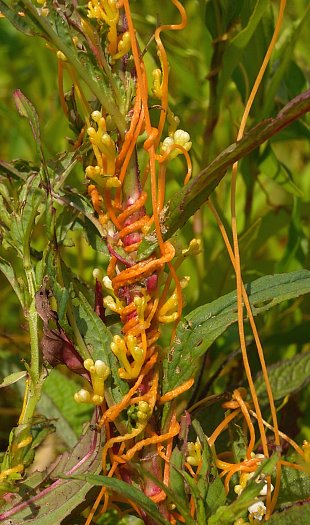
Small clusters of flowers develop at intervals along the stems on greenish yellow peduncles and pedicels that are glabrous. The pedicels of the flowers are very short (less than 1 mm. in length). Each flower spans about 3 mm. across, consisting of a short-tubular calyx with 4 obtuse lobes, a short-tubular corolla with 4 ascending to erect lobes, 4 stamens, and a pistil with a pair of divergent styles. Less commonly, a flower may have 5 calyx lobes, 5 corolla lobes, and 5 stamens. The calyx is light green or pale yellow and glabrous, while the corolla is white and its lobes are ovate with blunt tips. The lobes of the calyx extend to about the sinuses of the corolla or a little less. Inside the corolla at the base of the stamens, there are fringed floral scales (requires at least a 10x hand lens to see). The blooming period occurs from mid-summer to early fall, lasting about 1½ months. The flowers may be slightly fragrant, and they are self-fertile. The flowers are replaced by globoid seed capsules spanning 3-5 mm. across; they are surrounded by their persistent calyces and the withered remnants of their corollas. Immature seed capsules are light green or pale yellowish green, but they become brown at maturity. Each capsule has 2 cells and contains up to 2 seeds per cell. The seeds are 1.0-1.5 mm. in length and ovoid in shape. While a young seedling has a rudimentary root system, it soon withers away after the seedling attaches itself to a suitable host plant. Without a host plant, the seedling soon dies as it lacks chlorophyll.

Cultivation: This parasitic vine is typically found in moist to wet open areas where the soil contains abundant organic material and possibly some silt or sand. Favored host plants are smartweeds (Persicaria spp.), but many other species of plants are also parasitized. During certain times of the year, the host plants may be found in shallow standing water. Smartweed Dodder can spread aggressively and seriously weaken its host plants. The small seeds of dodders (Cuscuta spp.) can remain viable for 5-7 years (Georgia, 1913).
Range & Habitat: The native Smartweed Dodder is scattered across most areas of Illinois, except possibly the NW section of the state (see Distribution Map). In those areas where this species occurs, it is uncommon to occasional. Habitats include moist to wet prairies, soggy thickets along rivers, fens, sandy marshes, and other wet places.
Faunal Associations: The floral nectar of dodders (Cuscuta spp.) attracts Halictid bees (Lasioglossum spp.), plasterer bees (Colletes spp.), and other small bees (Robertson, 1929). According to Müller (1873/1883), the flowers can attract moths. According to Georgia (1913), the seeds of these parasitic vines can pass through the digestive tracts of grazing animals (e.g., cattle, horses, etc.) and remain viable. Thus, these animals may help to spread these vines into new areas.
Photographic Location: Cowle's Bog (actually, a fen) at the Indiana Dunes National Lakeshore in NW Indiana.
Comments: Because of its bright orange stems, this is a conspicuous vine, especially when it develops into a sprawling mass that resembles a large pile of abandoned tangled string. This is quite a sight to behold. Smartweed Dodder can be distinguished from most species of dodders (Cuscuta spp.) by its 4-parted flowers (4 calyx lobes, 4 corolla lobes, and 4 stamens). Two exceptions are Hazel Dodder (Cuscuta coryli) and Buttonbush Dodder (Cuscuta cephalanthi), which also have 4-parted flowers. These latter two species have yellow stems, rather than bright orange stems. Compared to Smartweed Dodder, the corolla lobes of Hazel Dodder are more erect with acute and incurved tips, while the corolla lobes of Buttonbush Dodder are widely spreading. Aside from these species, other dodders in Illinois have 5-parted flowers (5 calyx lobes, 5 corolla lobes, and 5 stamens).